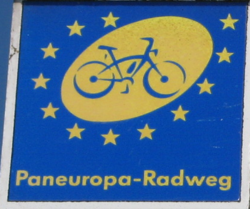Pan-European cycle route
The Pan-bike trail is an international long-distance cycle path of France , Germany and the Czech Republic joins. The long-distance cycle route starts at Gare de l'Est in Paris and leads via Châlons-en-Champagne , Strasbourg , Heidelberg , Nuremberg and Pilsen to Prague . The route through the three countries is 1,537 kilometers long (640 kilometers in France, 673 kilometers in Germany and 227 kilometers in the Czech Republic).
history
As early as the Middle Ages, the Via Carolina or Golden Street was an important trade route between Nuremberg and Prague. This historical connection is also taken up by the long-distance cycle route.
In 2001, the long-distance cycle route was initiated by the Neustadt an der Waldnaab district together with the neighboring Czech communities. After the subsequent planning and signposting of the route, the route was officially released on April 12, 2008 in Nuremberg.
Route
France
Between Paris and Strasbourg, the cycle path mainly runs along canals. Often you cycle on asphalt or on water-bound lanes away from the roads right next to the canals or on side streets that are rarely used.
Germany
On the first section through Germany, the route goes from Strasbourg to Heidelberg through the wide Rhine Valley and then through the narrow Neckar Valley to Heilbronn . From Heilbronn it gets mountainous in the foothills of the Mainhardt Forest and the Waldenburg Mountains to Schwäbisch Hall . From Schwäbisch Hall, the route follows the Kocher for a short distance until it finally climbs steeply over to the Jagsttal and over the Frankenhöhe to Rothenburg ob der Tauber . From Rothenburg ob der Tauber up to the Altmühlquelle it is still mountainous, then it goes mainly downhill along the Bibert to Nuremberg. To the east of Nuremberg, the Paneuropean Cycle Path gradually climbs up to Neukirchen , and then changes over to the Naab Valley in constant ups and downs . In Neustadt, the cycle path leaves the Naab Valley and follows the route of the Bockl cycle path , a former railway line, to Eslarn and the Czech border at the Tillyschanz border crossing .
Czech Republic
In the Czech Republic, the bike path is changing its face. The Bohemian Forest is crossed on forest paths that pull up and down vigorously. The routing takes little account of the topography . The level of difficulty of the passage can be described as difficult or as a mountain bike route . In the forests, the road surface is often poor and there are inclines well over 10 percent. To the east of the city of Pilsen, the route runs mainly on back roads and more often through fields and meadows until it reaches the Berounka River . After a few kilometers, the mouth of the Berounka into the Vltava is reached. The Pan-Europe Cycle Route leads along Berounka and Moldau to the center of Prague.
literature
- Brochure Paneuropa-Radweg , contact district Neustadt ad Waldnaab - regional management
Web links
- Homepage about the Paneuropa-Radweg, managed by the Neustadt an der Waldnaab district office
- BicycleRoutes & Tours: Paneuropean Cycle Route - Paris-Prague , with map, GPS download, elevation profile, sights and accommodation
- Ouren-Wegweiser.de: Paneuropean cycle path with a detailed description of the cycle path
Individual evidence
- ↑ Paneuropa-Radweg connects Paris and Prague at http://www.spiegel.de . Retrieved June 17, 2017.
